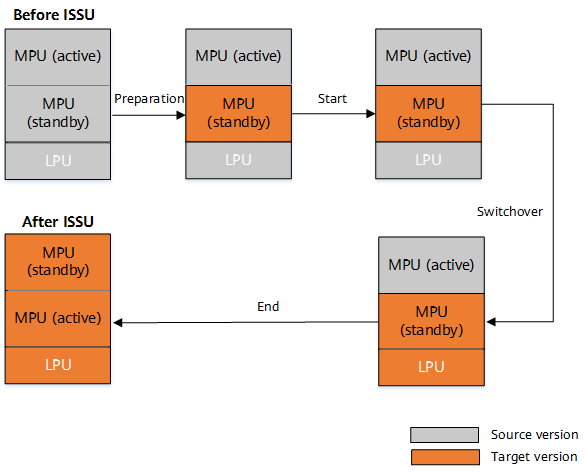What Is ISSU?
ISSU minimizes service traffic interruption time during a system software upgrade or rollback, improving service reliability.
Why Do We Need ISSU?
Upgrading system software of a device requires the device to restart. The device restart will interrupt service running and traffic forwarding. To relieve the impact of system upgrades on services, multiple equal-cost links can be established. Services can then be switched to the backup links during a software upgrade. However, network configurations must be modified in this case, which increases the error probability and prolongs the upgrade. Additionally, services may still be interrupted because some links may be overloaded.
ISSU is introduced to solve the problem of service interruption caused by system software upgrades.
How Does ISSU Work?
ISSU is implemented by separately upgrading the active and standby main processing units (MPUs). It supports data synchronization between active and standby MPUs in different versions and uses key technologies such as forwarding and control separation to shorten the service interruption time during an upgrade.
ISSU consists of the following phases:
- Preparation: The system checks whether ISSU conditions are met. If so, the standby MPU restarts using the new system software.
- Start: The system backs up data between the active and standby MPUs.
- Switchover: The standby MPU becomes the new active MPU, and Line Processing Units (LPUs) restart.
- End: The original active MPU restarts with the new system software. After the restart, it functions as the new standby MPU and ISSU is complete.
Before the switchover phase, you can stop the upgrade. Then the system rolls back to the source version.

ISSU flowchart
ISSU provides a version rollback mechanism to allow a system to roll back to the source version during an ISSU upgrade. This mechanism reduces risks of version upgrades. If the rollback occurs before the active/standby MPU switchover, the device performs smooth rollback without restart. In this case, traffic will not be lost. If the rollback occurs after the active/standby MPU switchover, the device restarts with the source system software.
Traditional Upgrade vs. ISSU
The following figure shows the differences between traditional upgrade and ISSU.

Traditional upgrade vs. ISSU
- Author: Chen Guixiang
- Updated on: 2024-02-27
- Views: 10505
- Average rating:








